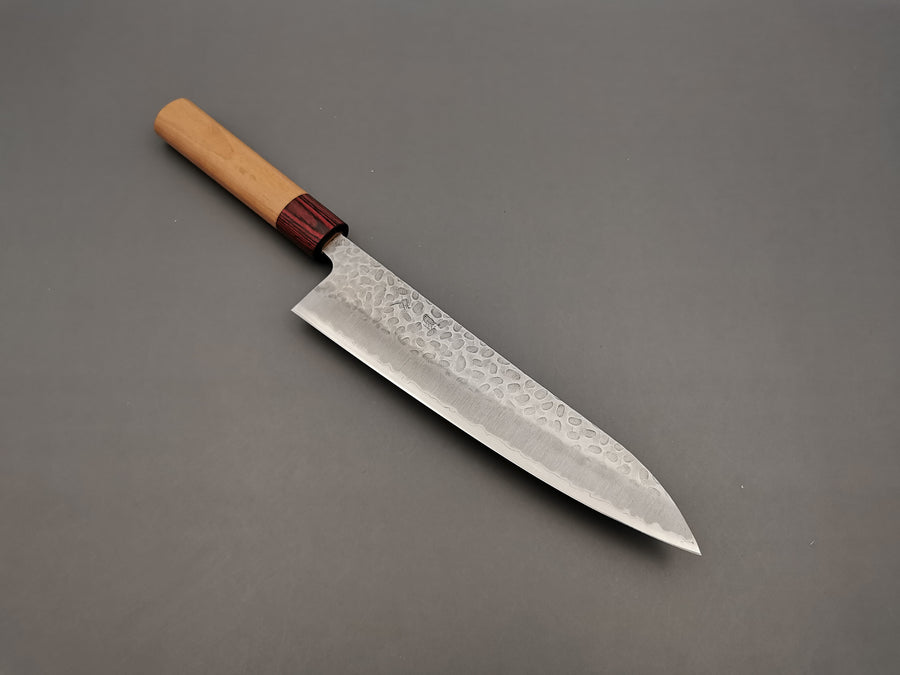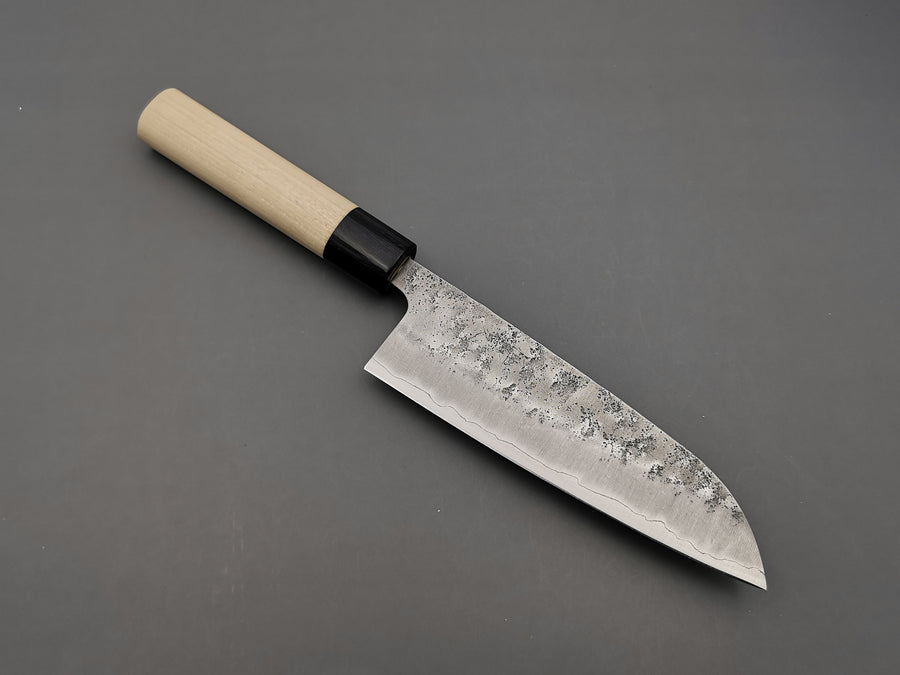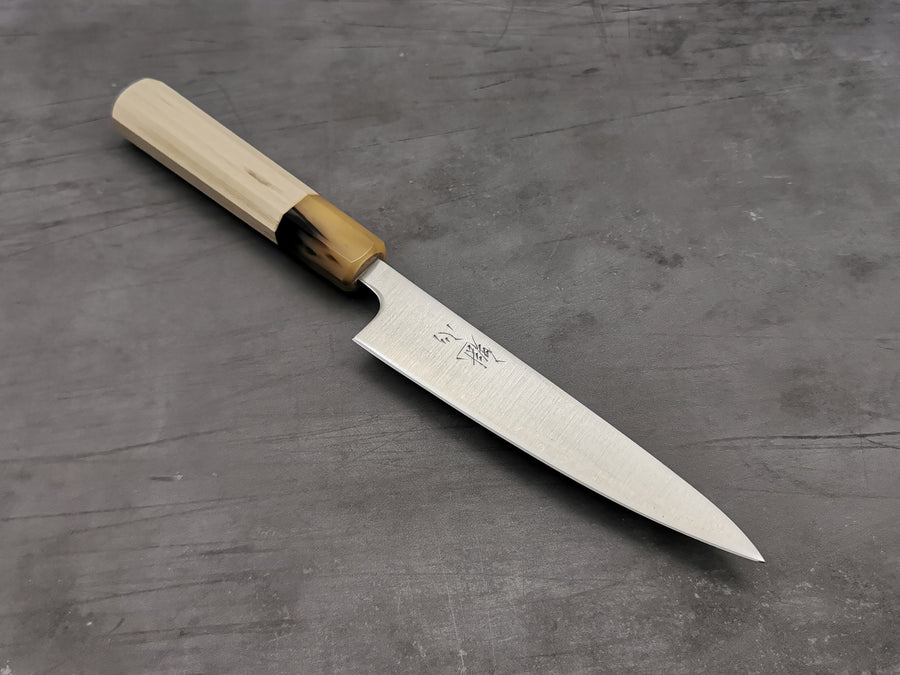Japanese chef knife styles
There is a massive range of Japanese knives that all perform different tasks and their shapes, sizes and design all vary significantly so here's a handy guide to some of the most common styles of chef knife you might encounter.
Gyuto (Multipurpose chef knife)
Typically ranging from around 180mm to 270mm with some examples being as small as 160mm and some as large as 360mm the Gyuto is the Japanese knife shape and profile that most closely matches the Western "chef knife" that most people will use on a day to day basis.
Typically quite tall at the heel and pointed towards the tip for precision work the gyuto suits a sliding cutting style but is also efficient for those who rock chop too so it's an excellent choice for all round use and is an ideal knife style, size and shape to look at when starting your collection.
Tsunehisa AS Tsuchime Gyuto 210mm - View all gyuto
Santoku (multi-purpose knife)
Santoku translates to "three virtues" (or three uses) which are slicing, dicing and chopping. It is the Japanese general purpose chef knife that you would use for most tasks and is typically around 160 to 180mm long. As with the gyuto, it's an all rounder that's great for most jobs and is a good choice if you just want one knife that does most things well.
Tsunehisa Ginsan santoku - View all santoku
Petty (Paring knife)
A petty knife is a small utility designed mainly for delicate work like cutting herbs or small fruits or vegetables, in the West you might call it a paring or utility knife.
They can range from a tiny 75mm to somewhere around 150mm. It's definitely a second knife in a lot of people's collection and is often paired with a gyuto or santoku so you've got the bigger all-round chef knife and a smaller petty for those more intricate jobs.
Nakamura Hamono Kaishin Petty - View all petty
Nakiri (Vegetable knife)
Despite its cleaver like appearance, the nakiri is definitely not one! In fact, it's a vegetable knife designed with a thin, straight edge and squared tip it allows you to slice all the way through vegetables without needing to twist the blade. The tall profile also helps with scooping your veg into the pot.
It's actually one of the most common knives in a Japanese kitchen unlike in the West where we tend to favour the gyuto and santoku a little more.
Tsunehisa AS Morado nakiri - View all nakiri
Bunka
A good general purpose knife that's a similar to a santoku or gyuto but with a more pronounced tip for intricate work. If you're considering an all rounder like the gyuto or santoku then check out the bunka too.
Yoshida Hamono ZDP189 Bunka - View all bunka
Sujihiki (Carving knife)
A long and thin carving knife - slim and long to allow fewer passes of the blade through boneless pieces of meat or vegetables which helps avoid tearing which gives a cleaner overall cut.
Honesuki
Typically quite thick along the spine and with a very sharp and pointed tip it's designed to get in and around bones and joints to strip out your cuts of meat easily.
Ko-Bunka
The little brother of the 'Bunka' (ko means small in Japanese), this boning knife is perfect for cleaning, dressing and cutting all types of meat. This handy little knife is a cross between a petty and its bigger brother the 'Bunka'.
Funayuki
A versatile all round knife, the Funayuki style of knife was traditionally used on Japanese fishing boats to prepare meals at sea and perform a range of cleaning and prep jobs. In Japan, typically only executive chefs are permitted to use this style of knife because the thin blade can easily chip in less skilled hands.
Sabaki
Sabaki means 'handling' in Japanese and is used primarily for handling and removing the meat from bones (but not cutting through them) easily and quickly.
Ko-bocho
Like a cross between a small santoku and a petty knife, the ko-bocho is ideally suited to a range of intricate roles primarily working with vegetables and foods that, as a general guide, you can hold in your hand while working.
Deba
A single edged heavy knife that is primarily used for filleting and deboning fish. Strong enough to be able to deal with fish but not recommended for meat bones other than chicken.
Usuba
Like the nakiri, the usuba is designed as a specialist vegetable knife but with some notable differences - its name translates to "thin blade" and unlike the nakiri, is a single bevel knife and either designed for left or right handed use. Typically they're found in the hands of more experienced chefs or knife users because they require a little more practice to master so if you're not entirely sure if it's for you there's a good chance a nakiri might be a better choice.
These are just a selection of the more common Japanese knives we stock and there are many more for ever more specific jobs.
If there's a type or brand of knife you'd like us to stock, please don't hesitate to contact us and let us know!
Helping you find the perfect knives & accessories
Cutting Edge Knives is a proudly independent family run small business established in 2011 and based in the picturesque town of Holmfirth, West Yorkshire in the UK.
We love the history and craftsmanship that goes into making Japanese chef knives and accessories and the excitement and enjoyment you experience when using a truly sharp knife in the kitchen. Over many years we've helped thousands of happy customers find their dream knife and look forward to helping you too.

About Us | Money Back Guarantee | Worldwide Shipping from UK | Contact




